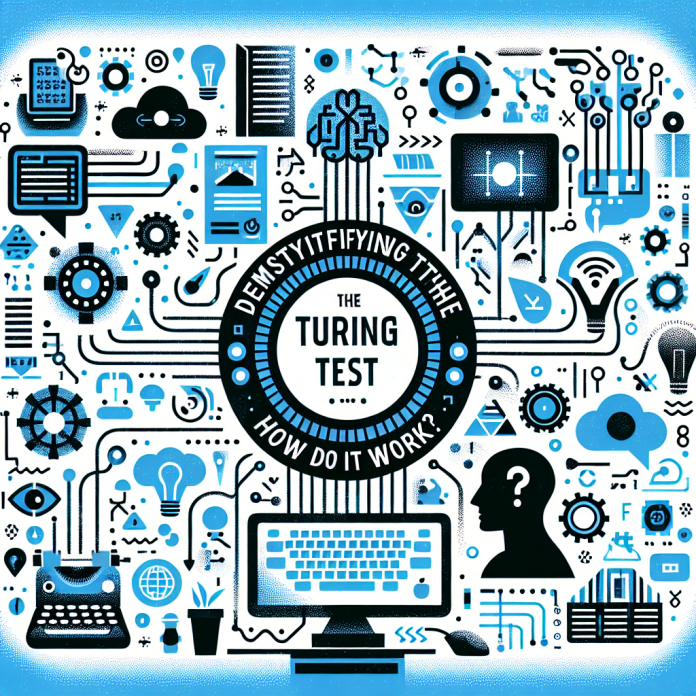**The Turing Test Explained: Can Machines Think Like Humans?**
In the world of artificial intelligence, there is a concept that has captured the imagination of scientists, philosophers, and sci-fi enthusiasts alike – The Turing Test. But what exactly is the Turing Test, and why is it so important in the field of AI? Let’s dive into the fascinating world of artificial intelligence and explore the intricacies of this groundbreaking test.
**The Origins of the Turing Test**
The Turing Test was proposed by the legendary mathematician and computer scientist Alan Turing in his seminal paper “Computing Machinery and Intelligence” in 1950. Turing was a pioneer in the field of AI and is often referred to as the father of modern computer science. In his paper, Turing posed the question: Can machines think?
To answer this question, Turing devised a simple yet profound test that would later become known as the Turing Test. The test involves a human interrogator engaging in a conversation with both a human and a machine (hidden from view). If the interrogator is unable to distinguish which responses are coming from the machine and which are coming from the human, then the machine is said to have passed the Turing Test.
**The Implications of the Turing Test**
The Turing Test holds immense significance in the field of artificial intelligence for several reasons. Firstly, it serves as a benchmark for gauging the intelligence of machines. If a machine can successfully mimic human behavior and thought processes to the point where it is indistinguishable from a human, then it can be said to possess a form of intelligence.
Secondly, the Turing Test raises profound philosophical questions about the nature of consciousness, intelligence, and what it truly means to think. Can a machine ever truly think like a human, or is it merely simulating intelligence based on pre-programmed responses? These are some of the complex questions that the Turing Test forces us to confront.
**The Evolution of the Turing Test**
Since its inception, the Turing Test has sparked intense debate and research in the field of artificial intelligence. Many computer scientists and AI researchers have attempted to create machines that can pass the Turing Test, leading to the development of sophisticated chatbots, virtual assistants, and AI systems.
One notable example is IBM’s Watson, a supercomputer that famously defeated human champions on the quiz show Jeopardy! Watson’s ability to understand natural language and generate coherent responses showcased the potential of AI to simulate human-level intelligence.
However, passing the Turing Test remains a formidable challenge for AI researchers. While machines can excel at specific tasks and exhibit impressive feats of computation, truly understanding and emulating human intelligence is a complex and multifaceted endeavor.
**Ethical Considerations**
The Turing Test also raises important ethical considerations regarding the future of AI and its impact on society. If machines were to pass the Turing Test and become indistinguishable from humans, what rights and responsibilities should they be afforded? Should we treat them as sentient beings capable of emotional experiences and moral reasoning, or as tools designed for human utility?
These are thorny ethical dilemmas that warrant careful consideration and thoughtful reflection as AI technology continues to advance at a rapid pace.
**Real-Life Examples**
To bring the concept of the Turing Test to life, let’s consider some real-life examples of AI applications that have come close to passing the test:
1. Chatbots such as Google Duplex and Apple’s Siri have made significant strides in natural language processing and conversational AI, enabling users to engage in seamless interactions with virtual assistants.
2. Deep learning algorithms like OpenAI’s GPT-3 have demonstrated remarkable language generation capabilities, producing coherent and contextually relevant text that can be challenging to distinguish from human writing.
3. Automated customer service bots used by companies like Amazon and Microsoft have become increasingly sophisticated in their ability to handle customer inquiries and provide personalized responses.
While these examples showcase the impressive capabilities of AI technology, it is essential to remember that passing the Turing Test requires more than surface-level mimicry. True intelligence involves understanding, empathy, creativity, and a host of cognitive abilities that are uniquely human.
**Conclusion**
In conclusion, the Turing Test represents a fundamental challenge in the field of artificial intelligence, probing the boundaries of machine intelligence and human cognition. As AI technology continues to advance, the debate around the Turing Test will only intensify, raising profound questions about the nature of intelligence, consciousness, and our relationship with machines.
While machines may one day pass the Turing Test and blur the line between human and artificial intelligence, the true test of AI lies not in mimicking humans but in enhancing our understanding of the world and ourselves. As we navigate the complex terrain of AI ethics and innovation, the Turing Test serves as a poignant reminder of the enduring quest to unlock the mysteries of the mind and the limitless potential of intelligent machines.

